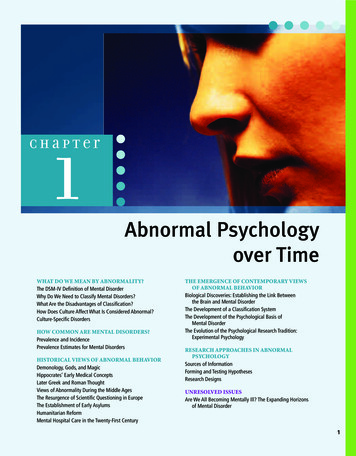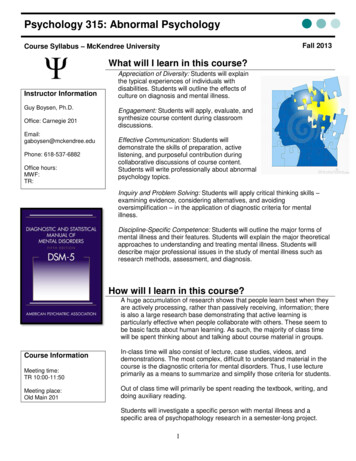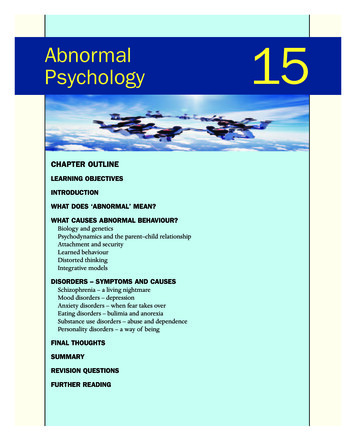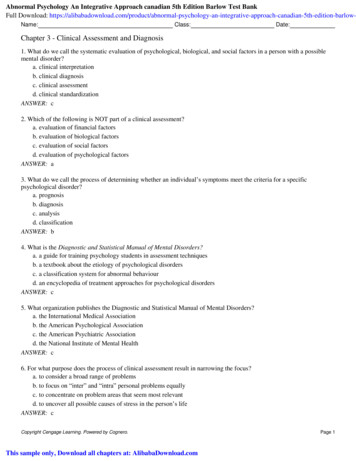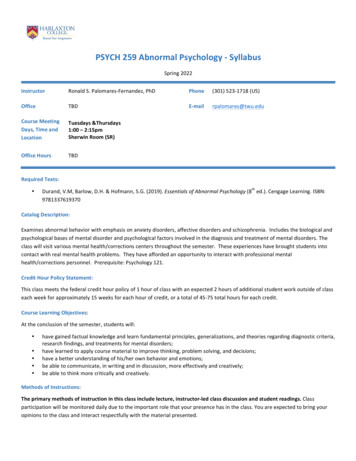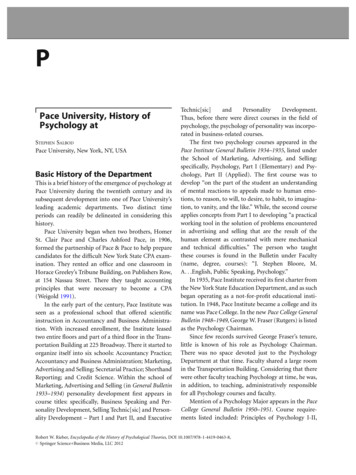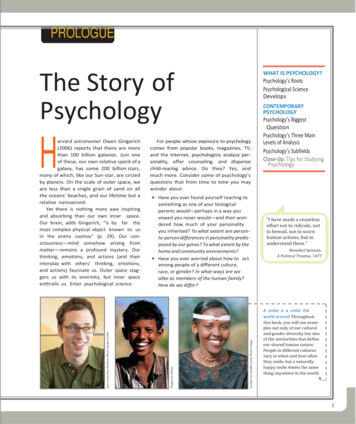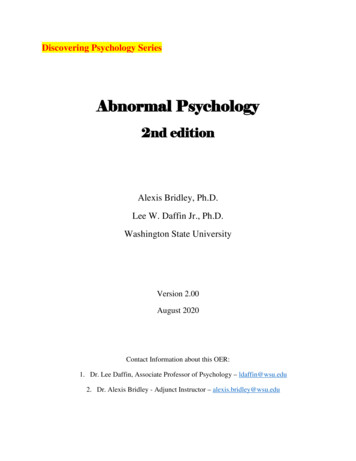
Transcription
Discovering Psychology SeriesAbnormal Psychology2nd editionAlexis Bridley, Ph.D.Lee W. Daffin Jr., Ph.D.Washington State UniversityVersion 2.00August 2020Contact Information about this OER:1. Dr. Lee Daffin, Associate Professor of Psychology – ldaffin@wsu.edu2. Dr. Alexis Bridley - Adjunct Instructor – alexis.bridley@wsu.edu
Table of ContentsPrefaceRecord of ChangesPart I. Setting the Stage Module 1: What is Abnormal Psychology?1-1 Module 2: Models of Abnormal Psychology2-1 Module 3: Clinical Assessment, Diagnosis, and Treatment3-1Part II. Mental Disorders – Block 1 Module 4: Mood Disorders4-1 Module 5: Trauma- and Stressor-Related Disorders5-1 Module 6: Dissociative Disorders6-1Part III. Mental Disorders – Block 2 Module 7: Anxiety Disorders7-1 Module 8: Somatic Symptom and Related Disorders8-1 Module 9: Obsessive-Compulsive and Related Disorders9-1Part IV. Mental Disorders – Block 3 Module 10: Eating Disorders10-1 Module 11: Substance-Related and Addictive Disorders11-1
Part V. Mental Disorders – Block 4 Module 12: Schizophrenia Spectrum and Other Psychotic Disorders12-1 Module 13: Personality Disorders13-1Part VI. Mental Disorders – Block 5 Module 14: Neurocognitive Disorders14-1 Module 15: Contemporary Issues in Psychopathology15-1GlossaryReferencesIndex
Record of ChangesEditionAs of DateChanges Made1.0Fall 2017Initial writing; feedback pending1.01Spring 2018Addition of Modules 2, 3, and 151.02Summer 2018Addition of Index, Glossary, and Preface; made minor edits basedon student feedback.1.03Summer 2019Proofreading edits2.00August 2020Proofreading edits and overall improvements such as end ofsection summaries and review questions. Added a Tokens ofAppreciation page. Added lecture slides courtesy of Arizona StateUniversity.
Tokens of AppreciationAugust 20, 2020Alexis and I want to offer a special thank you to Ms. Celeste Ernst, undergraduate within theonline Bachelor of Science degree in Psychology program, for her edits of the 1st edition duringthe spring 2020. Her changes, and our own, are integrated into the 2nd edition of the book and area dramatic improvement over the 1st edition. Thank you, Celeste.We would also like to extend a special thank you to Madeleine Stewart and Matt Meier, PsyD.,of the Department of Psychology at Arizona State University for the development of the lectureslides for this book. They did this work unsolicited and produced top quality presentations whichwe will include in a password protected page, along with additional ancillaries such as anInstructor’s Manual and test banks, in the very near future (i.e. hopefully by mid fall semester atthe latest but the slides in August) and for Instructors (Not students. Sorry). Thank you again foryour excellent work, Madeleine and Matt. It is more appreciated than you could ever imagine.And now to our reader. We hope you enjoy the book and please, if you see any issues whethertypographical, factual, or just want to suggest some type of addition to the material or anotherway to describe a concept, general formatting suggestion, etc. please let us know. The beauty ofOpen Education Resources (OER) is that we can literally make a minor change immediately andwithout the need for expensive printings of a new edition. And it’s available for everyone rightaway. If you have suggestions, please email them to either Alexis or myself (Lee Daffin) usingthe emails on the title page.Enjoy the 2nd edition of Abnormal Psychology.Lee DaffinOn behalf of, Alexis Bridley
2nd edition as of August 2020Part I. Setting the StageTopics Covered:1. What is Abnormal Psychology?2. Models of Abnormal Psychology3. Clinical Assessment, Diagnosis, and Treatment
2nd edition as of August 2020Part I. Setting the StageModule 1:What is Abnormal Psychology?1-1
2nd edition as of August 2020Module 1: What is Abnormal Psychology?Module OverviewCassie is an 18-year-old female from suburban Seattle, WA. She was a successful studentin high school, graduating valedictorian and obtaining a National Merit Scholarship for herperformance on the PSAT during her junior year. She was accepted to a university on theopposite side of the state, where she received additional scholarships giving her a free ride forher entire undergraduate education. Excited to start this new chapter in her life, Cassie’s parentsbegin the 5-hour commute to Pullman, where they will leave their only daughter for the first timein her life.The semester begins as it always does in late August. Cassie meets the challenge withenthusiasm and does well in her classes for the first few weeks of the semester, as expected.Sometime around Week 6, her friends notice she is despondent, detached, and falling behind inher work. After being asked about her condition, she replies that she is “just a bit homesick,” andher friends accept this answer as it is a typical response to leaving home and starting college formany students. A month later, her condition has not improved but worsened. She now regularlyshirks her responsibilities around her apartment, in her classes, and on her job. Cassie does nothang out with friends like she did when she first arrived for college and stays in bed most of theday. Concerned, Cassie’s friends contact Health and Wellness for help.Cassie’s story, though hypothetical, is true of many Freshmen leaving home for the firsttime to earn a higher education, whether in rural Washington state or urban areas such asChicago and Dallas. Most students recover from this depression and go on to be functionalmembers of their collegiate environment and accomplished scholars. Some students learn to cope1-2
2nd edition as of August 2020on their own while others seek assistance from their university’s health and wellness center orfrom friends who have already been through the same ordeal. These are normal reactions.However, in cases like Cassie's, the path to recovery is not as clear. Instead of learning how tocope, their depression increases until it reaches clinical levels and becomes an impediment tosuccess in multiple domains of life such as home, work, school, and social circles.In Module 1, we will explore what it means to display abnormal behavior, what mentaldisorders are, and how society views it both today and has throughout history. Then we willreview research methods used by psychologists in general and how they are adapted to studyabnormal behavior/mental disorders. We will conclude with an overview of what mental healthprofessionals do.Module Outline 1.1. Understanding Abnormal Behavior 1.2. Classifying Mental Disorders 1.3. The Stigma of Mental Illness 1.4. The History of Mental Illness 1.5. Research Methods in Psychopathology 1.6. Mental Health Professionals, Societies, and JournalsModule Learning Outcomes Explain what it means to display abnormal behavior. Clarify how mental health professionals classify mental disorders. Describe the effect of stigma on those who have a mental illness.1-3
2nd edition as of August 2020 Outline the history of mental illness. Describe the research methods used to study abnormal behavior and mental illness. Identify types of mental health professionals, societies they may join, and journalsthey can publish their work in.1.1. Understanding Abnormal BehaviorSection Learning Objectives Describe the disease model and its impact on the field of psychology throughouthistory. Describe positive psychology. Define abnormal behavior. Explain the concept of dysfunction as it relates to mental illness. Explain the concept of distress as it relates to mental illness. Explain the concept of deviance as it relates to mental illness. Explain the concept of dangerousness as it relates to mental illness. Define culture and social norms. Clarify the cost of mental illness on society. Define abnormal psychology, psychopathology, and mental disorders.1-4
2nd edition as of August 20201.1.1. Understanding Abnormal BehaviorTo understand what abnormal behavior is, we first have to understand what normalbehavior is. Normal really is in the eye of the beholder, and most psychologists have found iteasier to explain what is wrong with people then what is right. How so?Psychology worked with the disease model for over 60 years, from about the late 1800sinto the middle part of the 19th century. The focus was simple – curing mental disorders - andincluded such pioneers as Freud, Adler, Klein, Jung, and Erickson. These names are synonymouswith the psychoanalytical school of thought. In the 1930s, behaviorism, under B.F. Skinner,presented a new view of human behavior. Simply, human behavior could be modified if thecorrect combination of reinforcements and punishments were used. This viewpoint espoused thedominant worldview of the time – mechanism – which presented the world as a great machineexplained through the principles of physics and chemistry. In it, human beings serve as smallermachines in the larger machine of the universe.Moving into the mid to late 1900s, we developed a more scientific investigation ofmental illness, which allowed us to examine the roles of both nature and nurture and to developdrug and psychological treatments to “make miserable people less miserable.” Though this wasan improvement, there were three consequences as pointed out by Martin Seligman in his 2008TED Talk entitled, “The new era of positive psychology.” These are: “The first was moral; that psychologists and psychiatrists became victimologists,pathologizers; that our view of human nature was that if you were in trouble, bricksfell on you. And we forgot that people made choices and decisions. We forgotresponsibility. That was the first cost.”1-5
2nd edition as of August 2020 “The second cost was that we forgot about you people. We forgot about improvingnormal lives. We forgot about a mission to make relatively untroubled peoplehappier, more fulfilled, more productive. And "genius," "high-talent," became a dirtyword. No one works on that.” “And the third problem about the disease model is, in our rush to do something aboutpeople in trouble, in our rush to do something about repairing damage, it neveroccurred to us to develop interventions to make people happier -- positiveinterventions.”Starting in the 1960s, figures such as Abraham Maslow and Carl Rogers sought toovercome the limitations of psychoanalysis and behaviorism by establishing a "third force"psychology, also known as humanistic psychology. As Maslow said,The science of psychology has been far more successful on the negative than on thepositive side; it has revealed to us much about man’s shortcomings, his illnesses, his sins,but little about his potentialities, his virtues, his achievable aspirations, or his fullpsychological height. It is as if psychology had voluntarily restricted itself to only half itsrightful jurisdiction, and that the darker, meaner half. (Maslow, 1954, p. 354).Humanistic psychology instead addressed the full range of human functioning and focused onpersonal fulfillment, valuing feelings over intellect, hedonism, a belief in human perfectibility,emphasis on the present, self-disclosure, self-actualization, positive regard, client centeredtherapy, and the hierarchy of needs. Again, these topics were in stark contrast to much of thework being done in the field of psychology up to and at this time.In 1996, Martin Seligman became the president of the American PsychologicalAssociation (APA) and called for a positive psychology or one that had a more positive1-6
2nd edition as of August 2020conception of human potential and nature. Building on Maslow and Roger’s work, he ushered inthe scientific study of such topics as happiness, love, hope, optimism, life satisfaction, goalsetting, leisure, and subjective well-being. Though positive and humanistic psychology havesimilarities, their methodology was much different. While humanistic psychology generallyrelied on qualitative methods, positive psychology utilizes a quantitative approach and aims tohelp people make the most out of life’s setbacks, relate well to others, find fulfillment increativity, and find lasting meaning and e.com.au/what is positive psychology.html).So, to understand what normal behavior is, do we look to positive psychology for anindication, or do we first define abnormal behavior and then reverse engineer a definition of whatnormal is? Our preceding discussion gave suggestions about what normal behavior is, but couldthe darker elements of our personality also make up what is normal to some extent? Possibly.The one truth is that no matter what behavior we display, if taken to the extreme, it can becomedisordered – whether trying to control others through social influence or helping people in analtruistic fashion. As such, we can consider abnormal behavior to be a combination of personaldistress, psychological dysfunction, deviance from social norms, dangerousness to self andothers, and costliness to society.1.1.2. How do we determine what abnormal behavior is?In the previous section we showed that what we might consider normal behavior isdifficult to define. Equally challenging is understanding what abnormal behavior is, which maybe surprising to you. A publication which you will become intimately familiar with throughoutthis book, the American Psychiatric Association's Diagnostic and Statistical Manual of Mental1-7
2nd edition as of August 2020Disorders 5th edition (DSM-5), states that though "no definition can capture all aspects of alldisorders in the range contained in the DSM-5" certain aspects are required. These include: Dysfunction – Includes “clinically significant disturbance in an individual’scognition, emotion regulation, or behavior that reflects a dysfunction in thepsychological, biological, or developmental processes underlying mental functioning”(pg. 20). Abnormal behavior, therefore, has the capacity to make well-being difficultto obtain and can be assessed by looking at an individual’s current performance andcomparing it to what is expected in general or how the person has performed in thepast. As such, a good employee who suddenly demonstrates poor performance maybe experiencing an environmental demand leading to stress and ineffective copingmechanisms. Once the demand resolves itself, the person’s performance should returnto normal according to this principle. Distress – When the person experiences a disabling condition “in social,occupational, or other important activities” (pg. 20). Distress can take the form ofpsychological or physical pain, or both concurrently. Alone though, distress is notsufficient enough to describe behavior as abnormal. Why is that? The loss of a lovedone would cause even the most “normally” functioning individual pain. An athletewho experiences a career-ending injury would display distress as well. Suffering ispart of life and cannot be avoided. And some people who exhibit abnormal behaviorare generally positive while doing so. Deviance – Closer examination of the word abnormal indicates a move away fromwhat is normal, or the mean (i.e., what would be considered average and in this casein relation to behavior), and so is behavior that infrequently occurs (sort of an outlier1-8
2nd edition as of August 2020in our data). Our culture, or the totality of socially transmitted behaviors, customs,values, technology, attitudes, beliefs, art, and other products that are particular to agroup, determines what is normal. Thus, a person is said to be deviant when he or shefails to follow the stated and unstated rules of society, called social norms. Socialnorms changes over time due to shifts in accepted values and expectations. Forinstance, homosexuality was taboo in the U.S. just a few decades ago, but today, it isgenerally accepted. Likewise, PDAs, or public displays of affection, do not cause asecond look by most people unlike the past when these outward expressions of lovewere restricted to the privacy of one’s own house or bedroom. In the U.S., crying isgenerally seen as a weakness for males. However, if the behavior occurs in thecontext of a tragedy such as the Vegas mass shooting on October 1, 2017, in which 58people were killed and about 500 were wounded while attending the Route 91Harvest Festival, then it is appropriate and understandable. Finally, consider thatstatistically deviant behavior is not necessarily negative. Genius is an example ofbehavior that is not the norm.Though not part of the DSM conceptualization of what abnormal behavior is, manyclinicians add dangerousness to this list when behavior represents a threat to the safety of theperson or others. It is important to note that having a mental disorder does not imply a person isautomatically dangerous. The depressed or anxious individual is often no more a threat thansomeone who is not depressed, and as Hiday and Burns (2010) showed, dangerousness is morethe exception than the rule. Still, mental health professionals have a duty to report to lawenforcement when a mentally disordered individual expresses intent to harm another person or1-9
2nd edition as of August 2020themselves. It is important to point out that people seen as dangerous are also not automaticallymentally ill.1.1.3. The Costs of Mental IllnessThis leads us to wonder what the cost of mental illness is to society. The NationalAlliance on Mental Illness (NAMI) indicates that depression is the number one cause ofdisability across the world “and is a major contributor to the global burden of disease.” Seriousmental illness costs the United States an estimated 193 billion in lost earnings each year. Theyalso point out that suicide is the 10th leading cause of death in the U.S., and 90% of those whodie due to suicide have an underlying mental illness. Regarding children and teens, 37% ofstudents with a mental disorder age 14 and older drop out of school, which is the highest dropoutrate of any disability group, and 70% of youth in state and local juvenile justice systems have atleast one mental disorder. Source: heNumbers. In terms of worldwide impact, the World Economic Forum used 2010 data to estimate 2.5 trillion in global costs in 2010 and projected costs of 6 trillion by 2030. The costs formental illness are greater than the combined costs of cancer, diabetes, and respiratory disorders(Whiteford et al., 2013). And finally, “The Social Security Administration reports that in 2012,2.6 and 2.7 million people under age 65 with a mental illness-related disability received SSI andSSDI payments, respectively, which represents 43 and 27 percent of the total number of peoplereceiving such support, respectively” -by-the-numbers.shtml). So as you can see, the cost of mental illness is quite staggeringfor both the United States and other countries.1-10
2nd edition as of August 2020Check this out: Seven Facts about America’s Mental Health-Care -care-system/?utm term .12de8bc569411.1.4. Definition of abnormal psychology or psychopathologyOur discussion so far has concerned what normal and abnormal behavior is. We saw thatthe study of normal behavior falls under the providence of positive psychology. Similarly, thescientific study of abnormal behavior, with the intent to be able to predict reliably, explain,diagnose, identify the causes of, and treat maladaptive behavior, is what we refer to as abnormalpsychology. Abnormal behavior can become pathological and has led to the scientific study ofpsychological disorders, or psychopathology. From our previous discussion we can fashion thefollowing definition of a psychological or mental disorder: mental disorders are characterizedby psychological dysfunction, which causes physical and/or psychological distress or impairedfunctioning, and is not an expected behavior according to societal or cultural standards.1-11
2nd edition as of August 2020You should have learned the following in this section: Abnormal behavior is a combination of personal distress, psychologicaldysfunction, deviance from social norms, dangerousness to self and others,and costliness to society.Abnormal psychology is the scientific study of abnormal behavior, with theintent to be able to predict reliably, explain, diagnose, identify the causesof, and treat maladaptive behavior.The study of psychological disorders is called psychopathology.Mental disorders are characterized by psychological dysfunction, whichcauses physical and/or psychological distress or impaired functioning, andis not an expected behavior according to societal or cultural standards.Section 1.1 Review Questions1. What is the disease model and what problems existed with it? What was toovercome its limitations?2. Can we adequately define normal behavior? What about abnormalbehavior?3. What aspects are part of the American Psychiatric Association’s definitionof abnormal behavior?4. What is abnormal behavior? Psychopathology?5. How do we define mental disorders?1-12
2nd edition as of August 20201.2. Classifying Mental DisordersSection Learning Objectives Define and exemplify classification. Define nomenclature. Define epidemiology. Define the presenting problem and clinical description. Differentiate prevalence, incidence, and any subtypes. Define comorbidity. Define etiology. Define course. Define prognosis. Define treatment.Classification is not a foreign concept and as a student you have likely taken at least onebiology class that discussed the taxonomic classification system of Kingdom, Phylum, Class,Order, Family, Genus, and Species revolutionized by Swedish botanist, Carl Linnaeus. Youprobably even learned a witty mnemonic such as ‘King Phillip, Come Out For Goodness Sake’to keep the order straight. The Library of Congress uses classification to organize and arrangetheir book collections and includes such categories as B – Philosophy, Psychology, and Religion;H – Social Sciences; N – Fine Arts; Q – Science; R – Medicine; and T – Technology.Simply, classification is how we organize or categorize things. The second author’s wifehas been known to color-code her DVD collection by genre, movie title, and release date. It is1-13
2nd edition as of August 2020useful for us to do the same with abnormal behavior, and classification provides us with anomenclature, or naming system, to structure our understanding of mental disorders in ameaningful way. Of course, we want to learn as much as we can about a given disorder so wecan understand its cause, predict its future occurrence, and develop ways to treat it.Epidemiology is the scientific study of the frequency and causes of diseases and otherhealth-related states in specific populations such as a school, neighborhood, a city, country, andthe world. Psychiatric or mental health epidemiology refers to the occurrence of mentaldisorders in a population. In mental health facilities, we say that a patient presents with a specificproblem, or the presenting problem, and we give a clinical description of it, which includesinformation about the thoughts, feelings, and behaviors that constitute that mental disorder. Wealso seek to gain information about the occurrence of the disorder, its cause, course, andtreatment possibilities.Occurrence can be investigated in several ways. First, prevalence is the percentage ofpeople in a population that has a mental disorder or can be viewed as the number of casesdivided by the total number of people in the sample. For instance, if 20 people out of 100 havebipolar disorder, then the prevalence rate is 20%. Prevalence can be measured in several ways: Point prevalence indicates the proportion of a population that has the characteristicat a specific point in time. In other words, it is the number of active cases. Period prevalence indicates the proportion of a population that has the characteristicat any point during a given period of time, typically the past year. Lifetime prevalence indicates the proportion of a population that has had thecharacteristic at any time during their lives.1-14
2nd edition as of August 2020According to the National Survey on Drug Use and Health (NSDUH), in 2015 there wasan estimated 9.8 million U.S. adults aged 18 years or older with a serious mental illness, or 4%of all U.S. adults, and 43.4 million adults aged 18 years or older with any mental illness, or17.9% of all U.S. adults.Source: nce/index.shtmlIncidence indicates the number of new cases in a population over a specific period. Thismeasure is usually lower since it does not include existing cases as prevalence does. If you wishto know the number of new cases of social phobia during the past year (going from say Aug 21,2015 to Aug 20, 2016), you would only count cases that began during this time and ignore casesbefore the start date, even if people are currently afflicted with the mental disorder. Incidence isoften studied by medical and public health officials so that causes can be identified, and futurecases prevented.Finally, comorbidity describes when two or more mental disorders are occurring at thesame time and in the same person. The National Comorbidity Survey Replication (NCS-R) studyconducted by the National Institute of Mental Health (NIMH) and published in the June 6, 2005issue of the Archives of General Psychiatry, sought to discover trends in prevalence, impairment,and service use during the 1990s. The first study, conducted from 1980 to 1985, surveyed 20,000people from five different geographical regions in the U.S. A second study followed from 19901992 and was called the National Comorbidity Survey (NCS). The third study, the NCS-R, useda new nationally representative sample of the U.S. population, and found that 45% of those withone mental disorder met the diagnostic criteria for two or more disorders. The authors also foundthat the severity of mental illness, in regard to disability, is strongly related to comorbidity, and1-15
2nd edition as of August 2020that substance use disorders often result from disorders such as anxiety and bipolar mooddisorders. The implications of this are significant as services to treat substance abuse and mentaldisorders are often separate, despite the disorders appearing together.The etiology is the cause of the disorder. There may be social, biological, orpsychological explanations for the disorder which need to be understood to identify theappropriate treatment. Likewise, the effectiveness of a treatment may give some hint at the causeof the mental disorder. More on this later.The course of the disorder is its particular pattern. A disorder may be acute, meaning thatit lasts a short time, or chronic, meaning it persists for a long time. It can also be classified astime-limited, meaning that recovery will occur after some time regardless of whether anytreatment occurs.Prognosis is the anticipated course the mental disorder will take. A key factor indetermining the course is age, with some disorders presenting differently in childhood thanadulthood.Finally, we will discuss several treatment strategies in this book in relation to specificdisorders, and in a general fashion in Module 3. Treatment is any procedure intended to modifyabnormal behavior into normal behavior. The person suffering from the mental disorder seeksthe assistance of a trained professional to provide some degree of relief over a series of therapysessions. The trained mental health professional may prescribe medication or utilizepsychotherapy to bring about this change. Treatment may be sought from the primary careprovider, in an outpatient facility, or through inpatient care or hospitalization at a mental hospitalor psychiatric unit of a general hospital.1-16
2nd edition as of August 2020You should have learned the following in this section: Classification, or how we organize or categorize things, provides us with anomenclature, or naming system, to structure our understanding of mentaldisorders in a meaningful way.Epidemiology is the scientific study of the frequency and causes ofdiseases and other health-related states in specific populations.Prevalence is the percentage of people in a population that has a mentaldisorder or can be viewed as the number of cases divided by the totalnumber of people in the sample.Incidence indicates the number of new cases in a population over a specificperiod.Comorbidity describes when two or more mental disorders are occurring atthe same time and in the same person.The etiology is the cause of a disorder while the course is its particularpattern and can be acute, chronic, or time-limited.Prognosis is the anticipated course the mental disorder will take.Section 1.2 Review Questions1.2.3.4.5.What is the importance of classification for the study of mental disorders?What information does a clinical description include?In what ways is occurrence investigated?What is the etiology of a mental illness?What is the relationship of course and prognosis to one another?1-17
2nd edition as of August 20201.3. The Stigma of Mental IllnessSection Learning Objectives Clarify the importance of social cognition theory in understanding why people do notseek care. Define categories and schemas. Define stereotypes and heuristics. Describe social identity theory and its consequences. Differentiate between prejudice and discrimination. Contrast implicit and explicit attitudes. Explain the concept of stigma and its three forms. Define courtesy stigma. Describe what the literature shows about stigma.In the previous section, we discussed the fact that care can be sought out in a variety ofways. The problem is that many people who need care never seek it out. Why is that? Wealready know that society dictate
psychology, also known as humanistic psychology. As Maslow said, The science of psychology has been far more successful on the negative than on the positive side; it has revealed to us much about man’s shortcomings, his illnesses, his sins, but little about his potentialit
